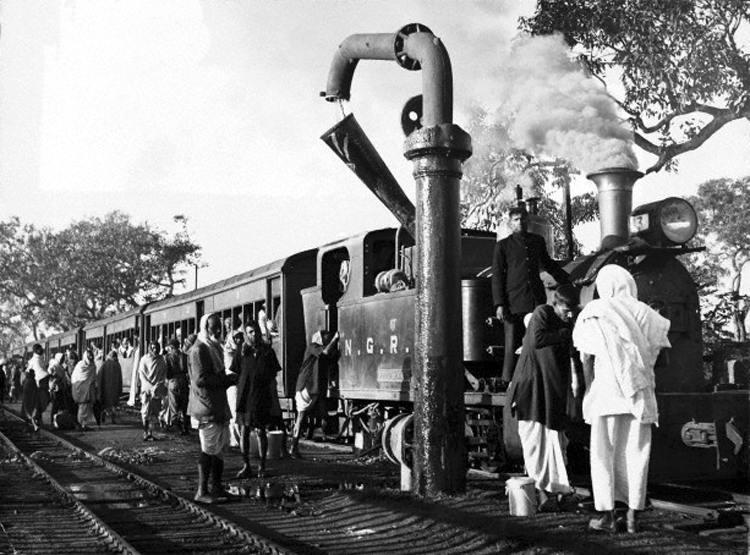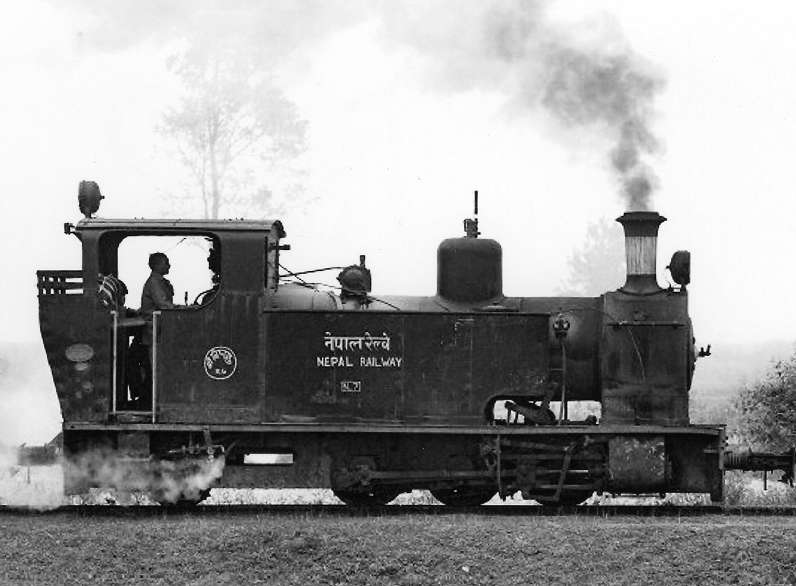|
Nepal Government Railway (NGR)
The Nepal Government Railway (NGR) ( ne, नेपाल गभर्मेन्ट रेलवे) was Nepal's first railway in Nepal. Established in 1927 and closed in 1965, it linked Amlekhganj with Raxaul across the border in India in the south. The Narrow gauge railway, narrow gauge railway was 47 km long. History In 1923, a short narrow gauge railway was built by J. V. Collier of the Indian Forest Service to transport Nepalese timber to India. Collier had been assigned by Nepal's Rana dynasty, Rana prime minister to manage the forest department in Nepal. In the winter of 1924, Martin's Light Railways, Martin and Co. of Kolkata conducted a survey to construct a light railway from the border north to Bichako (Amlekhganj). Construction began in March 1926, and the Nepal Government Railway opened on 16 February 1927. The narrow gauge railway used a track gauge of . The railway possessed seven steam locomotives, 12 coaches and 82 wagons. It operated steam-powered Garrat ... [...More Info...] [...Related Items...] OR: [Wikipedia] [Google] [Baidu] |
Narrow Gauge
A narrow-gauge railway (narrow-gauge railroad in the US) is a railway with a track gauge narrower than standard . Most narrow-gauge railways are between and . Since narrow-gauge railways are usually built with tighter curves, smaller structure gauges, and lighter rails, they can be less costly to build, equip, and operate than standard- or broad-gauge railways (particularly in mountainous or difficult terrain). Lower-cost narrow-gauge railways are often used in mountainous terrain, where engineering savings can be substantial. Lower-cost narrow-gauge railways are often built to serve industries as well as sparsely populated communities where the traffic potential would not justify the cost of a standard- or broad-gauge line. Narrow-gauge railways have specialised use in mines and other environments where a small structure gauge necessitates a small loading gauge. In some countries, narrow gauge is the standard; Japan, Indonesia, Taiwan, New Zealand, South Africa, and the Aust ... [...More Info...] [...Related Items...] OR: [Wikipedia] [Google] [Baidu] |
Beyer, Peacock & Company
Beyer, Peacock and Company was an English railway locomotive manufacturer with a factory in Openshaw, Manchester. Founded by Charles Beyer, Richard Peacock and Henry Robertson, it traded from 1854 until 1966. The company exported locomotives, and machine tools to service them, throughout the world. Founders German-born Charles Beyer had undertaken engineering training related to cotton milling in Dresden before moving to England in 1831 aged 21. He secured employment as a draughtsman at Sharp, Roberts and Company's Atlas works in central Manchester, which manufactured cotton mill machinery and had just started building locomotives for the Liverpool and Manchester Railway. There he was mentored by head engineer and prolific inventor of cotton mill machinery, Richard Roberts. By the time he resigned 22 years later he was well established as the company's head engineer; he had been involved in producing more than 600 locomotives. Richard Peacock had been chief engineer of the Ma ... [...More Info...] [...Related Items...] OR: [Wikipedia] [Google] [Baidu] |
Railway Companies Disestablished In 1965
Rail transport (also known as train transport) is a means of transport that transfers passengers and goods on wheeled vehicles running on rails, which are incorporated in tracks. In contrast to road transport, where the vehicles run on a prepared flat surface, rail vehicles (rolling stock) are directionally guided by the tracks on which they run. Tracks usually consist of steel rails, installed on sleepers (ties) set in ballast, on which the rolling stock, usually fitted with metal wheels, moves. Other variations are also possible, such as "slab track", in which the rails are fastened to a concrete foundation resting on a prepared subsurface. Rolling stock in a rail transport system generally encounters lower frictional resistance than rubber-tyred road vehicles, so passenger and freight cars (carriages and wagons) can be coupled into longer trains. The operation is carried out by a railway company, providing transport between train stations or freight customer faciliti ... [...More Info...] [...Related Items...] OR: [Wikipedia] [Google] [Baidu] |
Railway Companies Established In 1927
Rail transport (also known as train transport) is a means of transport that transfers passengers and goods on wheeled vehicles running on rails, which are incorporated in tracks. In contrast to road transport, where the vehicles run on a prepared flat surface, rail vehicles (rolling stock) are directionally guided by the tracks on which they run. Tracks usually consist of steel rails, installed on sleepers (ties) set in ballast, on which the rolling stock, usually fitted with metal wheels, moves. Other variations are also possible, such as "slab track", in which the rails are fastened to a concrete foundation resting on a prepared subsurface. Rolling stock in a rail transport system generally encounters lower frictional resistance than rubber-tyred road vehicles, so passenger and freight cars (carriages and wagons) can be coupled into longer trains. The operation is carried out by a railway company, providing transport between train stations or freight customer faciliti ... [...More Info...] [...Related Items...] OR: [Wikipedia] [Google] [Baidu] |
Defunct Transport Companies Of Nepal
{{Disambiguation ...
Defunct (no longer in use or active) may refer to: * ''Defunct'' (video game), 2014 * Zombie process or defunct process, in Unix-like operating systems See also * * :Former entities * End-of-life product * Obsolescence Obsolescence is the state of being which occurs when an object, service, or practice is no longer maintained or required even though it may still be in good working order. It usually happens when something that is more efficient or less risky r ... [...More Info...] [...Related Items...] OR: [Wikipedia] [Google] [Baidu] |
Defunct Railway Companies
{{Disambiguation ...
Defunct (no longer in use or active) may refer to: * ''Defunct'' (video game), 2014 * Zombie process or defunct process, in Unix-like operating systems See also * * :Former entities * End-of-life product * Obsolescence Obsolescence is the state of being which occurs when an object, service, or practice is no longer maintained or required even though it may still be in good working order. It usually happens when something that is more efficient or less risky r ... [...More Info...] [...Related Items...] OR: [Wikipedia] [Google] [Baidu] |
Nepal Railways
The Nepal Railway Company Ltd. (in short Nepal Railway), reporting mark: NRW / ने. रे) is a state-owned company under Department of Railways (DORW) which operates passenger train services in Nepal. Currently it operates passenger transport service on the line from Jainagar, India to Kurtha, Nepal. History There were three railway lines in Nepal, all narrow gauge lines: * Nepal Government Railway (NGR) * Nepal Janakpur Jaynagar Railway (NJJR) * Koshi Railway Nepal Government Railway The first railway in Nepal was the Nepal Government Railway (NGR), a narrow gauge railway, built by the British in 1927, during the Rana period. The railway connected Raxaul in British India with Amlekhganj in the Kingdom of Nepal. This line allowed people from different areas of the country to reach Amlekhganj, and helped move heavy vehicles to Bhimphedi. It was then possible to reach Kathmandu from Bhimphedi on foot. The railway possessed seven steam locomotives, 12 coaches and 8 ... [...More Info...] [...Related Items...] OR: [Wikipedia] [Google] [Baidu] |
Gorkha Regiments (India)
Since the independence of India in 1947, as per the terms of the Britain–India–Nepal Tripartite Agreement, six Gorkha regiments, formerly part of the British Indian Army, became part of the Indian Army and have served ever since. The troops are mainly from ethnic Gurkha communities of Nepal. A seventh Gorkha Rifles regiment was re-raised in the Indian Army after Independence to accommodate Gorkha soldiers of 7th Gurkha Rifles and the 10th Gurkha Rifles who chose not to transfer to the British Army. History Origins Impressed by the fighting qualities displayed by the Gorkhas during the Gurkha War, Sir David Ochterlony was quick to realise the potential of the Gorkhas in the British Indian Army. Until then, Gorkha defectors were generally used as irregular forces. On 24 April 1815, the first battalion of the Gorkha Regiment, was raised as the Nasiri regiment. This regiment later became the 1st King George's Own Gurkha Rifles, and saw action at the Maulun fort under Lieu ... [...More Info...] [...Related Items...] OR: [Wikipedia] [Google] [Baidu] |
Aama (1964 Film)
''Aama'' () is a 1964 Nepali film directed by Hira Singh Khatri in his directorial debut. The film is written by Durga Shrestha and Chaitya Devi. ''Aama'' was produced by King Mahendra of Nepal under the banner of Information Department of Government of Nepal (formally Royal Nepal Film Corporation). The film stars Shiva Shankar and Bhuwan Chand, with Basundhara Bhusal, Hira Singh Khatri and Hari Prasad Rimal in supporting roles. It follows a young man who returns home after serving in his country's army. Hira Singh Khatri, was requested by Mahendra of Nepal to direct ''Aama.'' The film's post-production and indoor filming were mainly done in Kolkata, India. It was released on 7 October 1964. After the release, ''Aama'' became the first Nepalese film to be produced in Nepal. After the film's release in Nepal, it quickly became popular in the country. After the success of ''Aama'', Khatri directed the films '' Hijo Aaja Bholi'' (1967), and ''Parivartan'' (1971) for the Nepalese ... [...More Info...] [...Related Items...] OR: [Wikipedia] [Google] [Baidu] |
Nepali Language
Nepali (; , ) is an Indo-Aryan language native to the Himalayas region of South Asia. It is the official, and most widely spoken, language of Nepal, where it also serves as a '' lingua franca''. Nepali has official status in the Indian state of Sikkim and in the Gorkhaland Territorial Administration of West Bengal. It is spoken by about a quarter of Bhutan's population. Nepali also has a significant number of speakers in the states of Arunachal Pradesh, Assam, Himachal Pradesh, Manipur, Meghalaya, Mizoram and Uttarakhand. In Myanmar it is spoken by the Burmese Gurkhas. The Nepali diaspora in the Middle East, Brunei, Australia and worldwide also use the language. Nepali is spoken by approximately 16 million native speakers and another 9 million as a second language. Nepali is commonly classified within the Eastern Pahari group of the Northern zone of Indo-Aryan. The language originated from the Sinja Valley, Karnali Province then the capital city of the Khasa K ... [...More Info...] [...Related Items...] OR: [Wikipedia] [Google] [Baidu] |
World Bank
The World Bank is an international financial institution that provides loans and grants to the governments of low- and middle-income countries for the purpose of pursuing capital projects. The World Bank is the collective name for the International Bank for Reconstruction and Development (IBRD) and International Development Association (IDA), two of five international organizations owned by the World Bank Group. It was established along with the International Monetary Fund at the 1944 Bretton Woods Conference. After a slow start, its first loan was to France in 1947. In the 1970s, it focused on loans to developing world countries, shifting away from that mission in the 1980s. For the last 30 years, it has included NGOs and environmental groups in its loan portfolio. Its loan strategy is influenced by the Sustainable Development Goals as well as environmental and social safeguards. , the World Bank is run by a president and 25 executive directors, as well as 29 various vice ... [...More Info...] [...Related Items...] OR: [Wikipedia] [Google] [Baidu] |

.jpg)



